Report: The Impact of Employee Performance on Job Satisfaction
VerifiedAdded on 2021/04/24
|22
|4281
|981
Report
AI Summary
This report investigates the relationship between employee performance and job satisfaction, highlighting its importance in organizational behavior. It explores the impact of employee performance on job satisfaction. The report delves into the importance of the research, objectives, literature review, and research methodology, including the use of a positivism paradigm and a quantitative approach. It also covers data collection and analysis, ethical considerations, and a project plan. The literature review examines employee performance dimensions, performance evaluation, individual task proficiency, and the connection between job performance and satisfaction. Key concepts such as motivators, hygiene factors, and job satisfaction elements are also discussed. The report's objectives include examining the impact of performance elements, motivators, and hygiene factors on job satisfaction, and analyzing task proficiency and performance evaluation. The report concludes by emphasizing the significance of this relationship for organizations seeking to attract and retain skilled employees and foster a positive work environment.
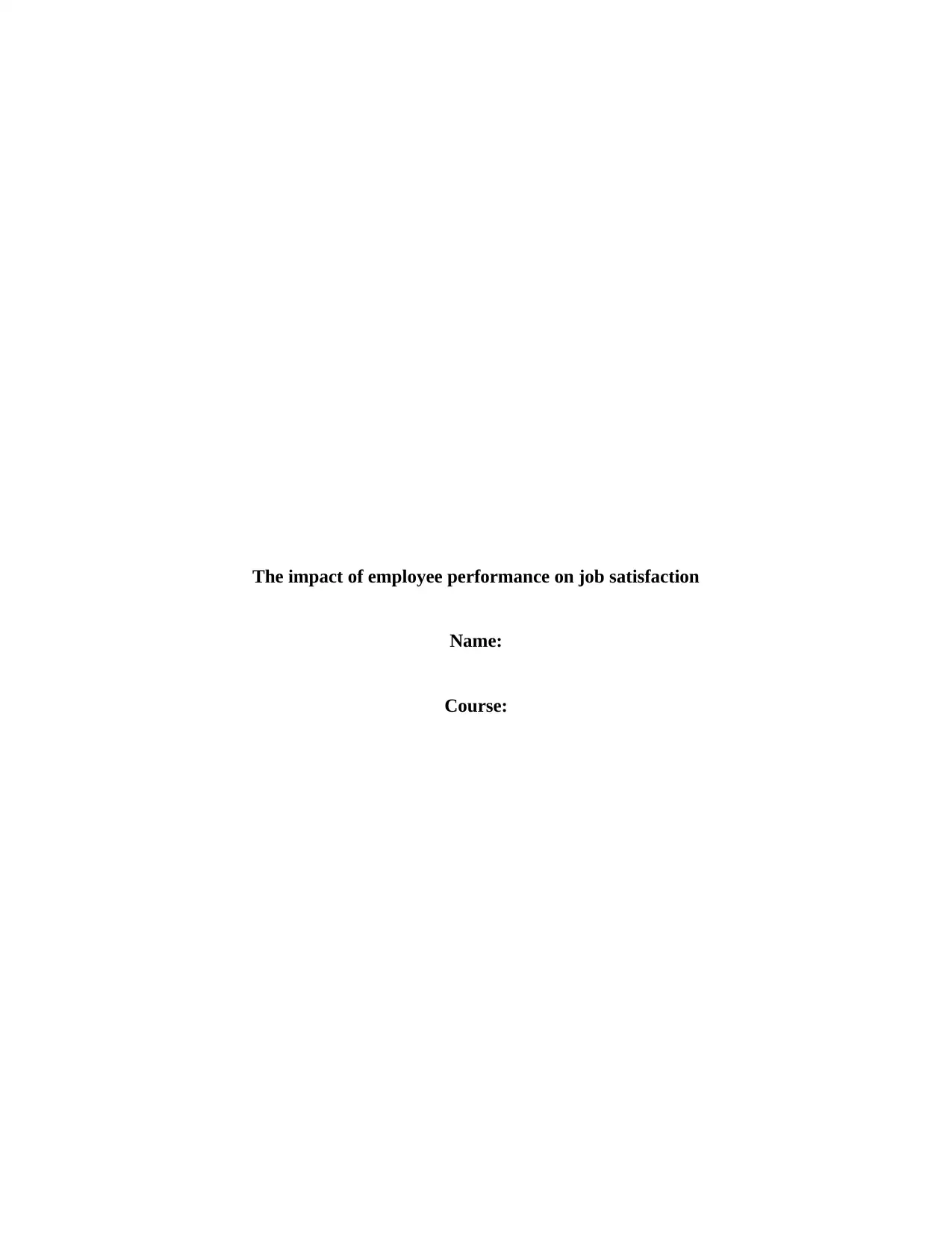
The impact of employee performance on job satisfaction
Name:
Course:
Name:
Course:
Paraphrase This Document
Need a fresh take? Get an instant paraphrase of this document with our AI Paraphraser
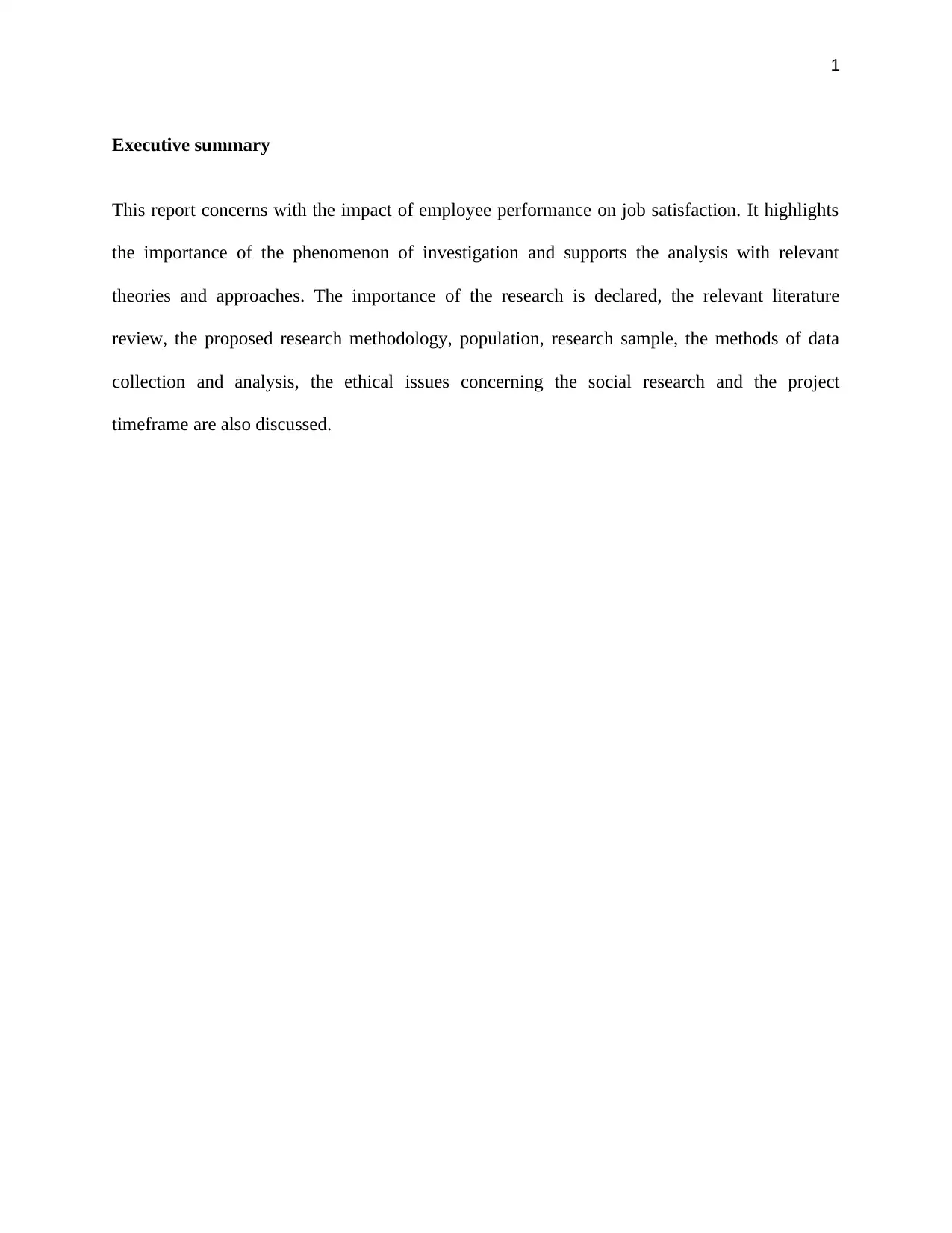
1
Executive summary
This report concerns with the impact of employee performance on job satisfaction. It highlights
the importance of the phenomenon of investigation and supports the analysis with relevant
theories and approaches. The importance of the research is declared, the relevant literature
review, the proposed research methodology, population, research sample, the methods of data
collection and analysis, the ethical issues concerning the social research and the project
timeframe are also discussed.
Executive summary
This report concerns with the impact of employee performance on job satisfaction. It highlights
the importance of the phenomenon of investigation and supports the analysis with relevant
theories and approaches. The importance of the research is declared, the relevant literature
review, the proposed research methodology, population, research sample, the methods of data
collection and analysis, the ethical issues concerning the social research and the project
timeframe are also discussed.

2
⊘ This is a preview!⊘
Do you want full access?
Subscribe today to unlock all pages.

Trusted by 1+ million students worldwide
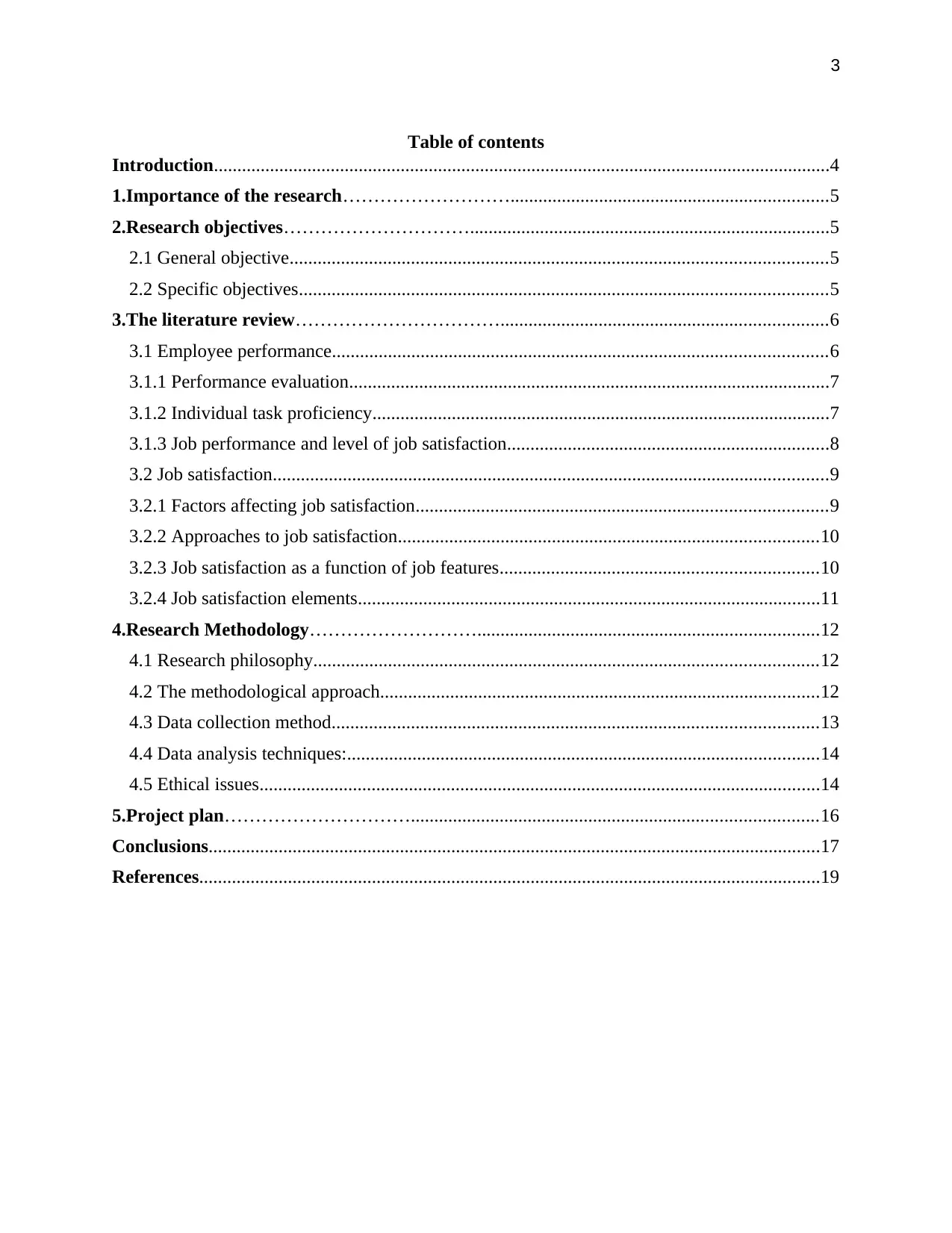
3
Table of contents
Introduction....................................................................................................................................4
1.Importance of the research………………………....................................................................5
2.Research objectives………………………….............................................................................5
2.1 General objective...................................................................................................................5
2.2 Specific objectives.................................................................................................................5
3.The literature review……………………………......................................................................6
3.1 Employee performance..........................................................................................................6
3.1.1 Performance evaluation.......................................................................................................7
3.1.2 Individual task proficiency..................................................................................................7
3.1.3 Job performance and level of job satisfaction.....................................................................8
3.2 Job satisfaction.......................................................................................................................9
3.2.1 Factors affecting job satisfaction........................................................................................9
3.2.2 Approaches to job satisfaction..........................................................................................10
3.2.3 Job satisfaction as a function of job features....................................................................10
3.2.4 Job satisfaction elements...................................................................................................11
4.Research Methodology……………………….........................................................................12
4.1 Research philosophy............................................................................................................12
4.2 The methodological approach..............................................................................................12
4.3 Data collection method........................................................................................................13
4.4 Data analysis techniques:.....................................................................................................14
4.5 Ethical issues........................................................................................................................14
5.Project plan………………………….......................................................................................16
Conclusions...................................................................................................................................17
References.....................................................................................................................................19
Table of contents
Introduction....................................................................................................................................4
1.Importance of the research………………………....................................................................5
2.Research objectives………………………….............................................................................5
2.1 General objective...................................................................................................................5
2.2 Specific objectives.................................................................................................................5
3.The literature review……………………………......................................................................6
3.1 Employee performance..........................................................................................................6
3.1.1 Performance evaluation.......................................................................................................7
3.1.2 Individual task proficiency..................................................................................................7
3.1.3 Job performance and level of job satisfaction.....................................................................8
3.2 Job satisfaction.......................................................................................................................9
3.2.1 Factors affecting job satisfaction........................................................................................9
3.2.2 Approaches to job satisfaction..........................................................................................10
3.2.3 Job satisfaction as a function of job features....................................................................10
3.2.4 Job satisfaction elements...................................................................................................11
4.Research Methodology……………………….........................................................................12
4.1 Research philosophy............................................................................................................12
4.2 The methodological approach..............................................................................................12
4.3 Data collection method........................................................................................................13
4.4 Data analysis techniques:.....................................................................................................14
4.5 Ethical issues........................................................................................................................14
5.Project plan………………………….......................................................................................16
Conclusions...................................................................................................................................17
References.....................................................................................................................................19
Paraphrase This Document
Need a fresh take? Get an instant paraphrase of this document with our AI Paraphraser
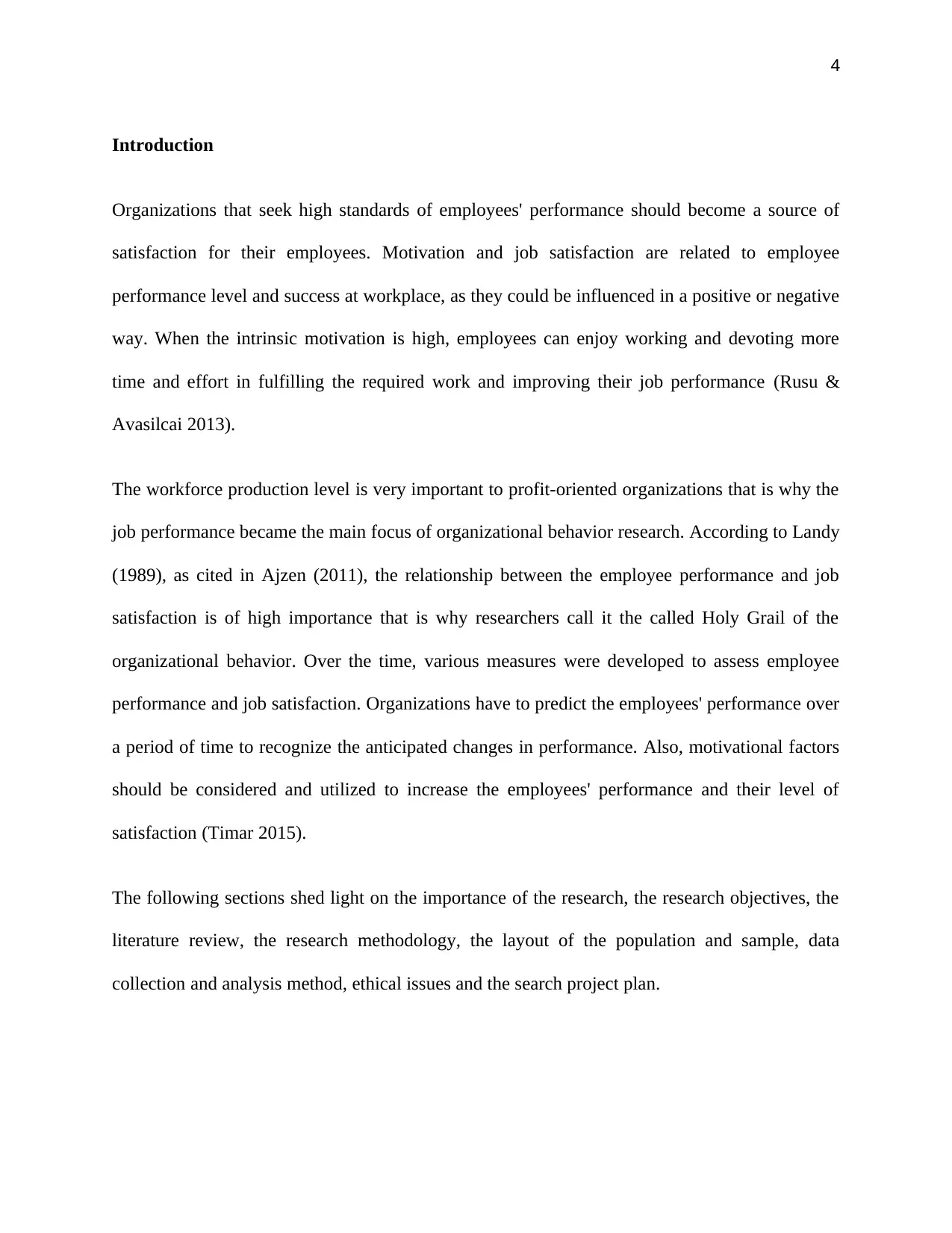
4
Introduction
Organizations that seek high standards of employees' performance should become a source of
satisfaction for their employees. Motivation and job satisfaction are related to employee
performance level and success at workplace, as they could be influenced in a positive or negative
way. When the intrinsic motivation is high, employees can enjoy working and devoting more
time and effort in fulfilling the required work and improving their job performance (Rusu &
Avasilcai 2013).
The workforce production level is very important to profit-oriented organizations that is why the
job performance became the main focus of organizational behavior research. According to Landy
(1989), as cited in Ajzen (2011), the relationship between the employee performance and job
satisfaction is of high importance that is why researchers call it the called Holy Grail of the
organizational behavior. Over the time, various measures were developed to assess employee
performance and job satisfaction. Organizations have to predict the employees' performance over
a period of time to recognize the anticipated changes in performance. Also, motivational factors
should be considered and utilized to increase the employees' performance and their level of
satisfaction (Timar 2015).
The following sections shed light on the importance of the research, the research objectives, the
literature review, the research methodology, the layout of the population and sample, data
collection and analysis method, ethical issues and the search project plan.
Introduction
Organizations that seek high standards of employees' performance should become a source of
satisfaction for their employees. Motivation and job satisfaction are related to employee
performance level and success at workplace, as they could be influenced in a positive or negative
way. When the intrinsic motivation is high, employees can enjoy working and devoting more
time and effort in fulfilling the required work and improving their job performance (Rusu &
Avasilcai 2013).
The workforce production level is very important to profit-oriented organizations that is why the
job performance became the main focus of organizational behavior research. According to Landy
(1989), as cited in Ajzen (2011), the relationship between the employee performance and job
satisfaction is of high importance that is why researchers call it the called Holy Grail of the
organizational behavior. Over the time, various measures were developed to assess employee
performance and job satisfaction. Organizations have to predict the employees' performance over
a period of time to recognize the anticipated changes in performance. Also, motivational factors
should be considered and utilized to increase the employees' performance and their level of
satisfaction (Timar 2015).
The following sections shed light on the importance of the research, the research objectives, the
literature review, the research methodology, the layout of the population and sample, data
collection and analysis method, ethical issues and the search project plan.
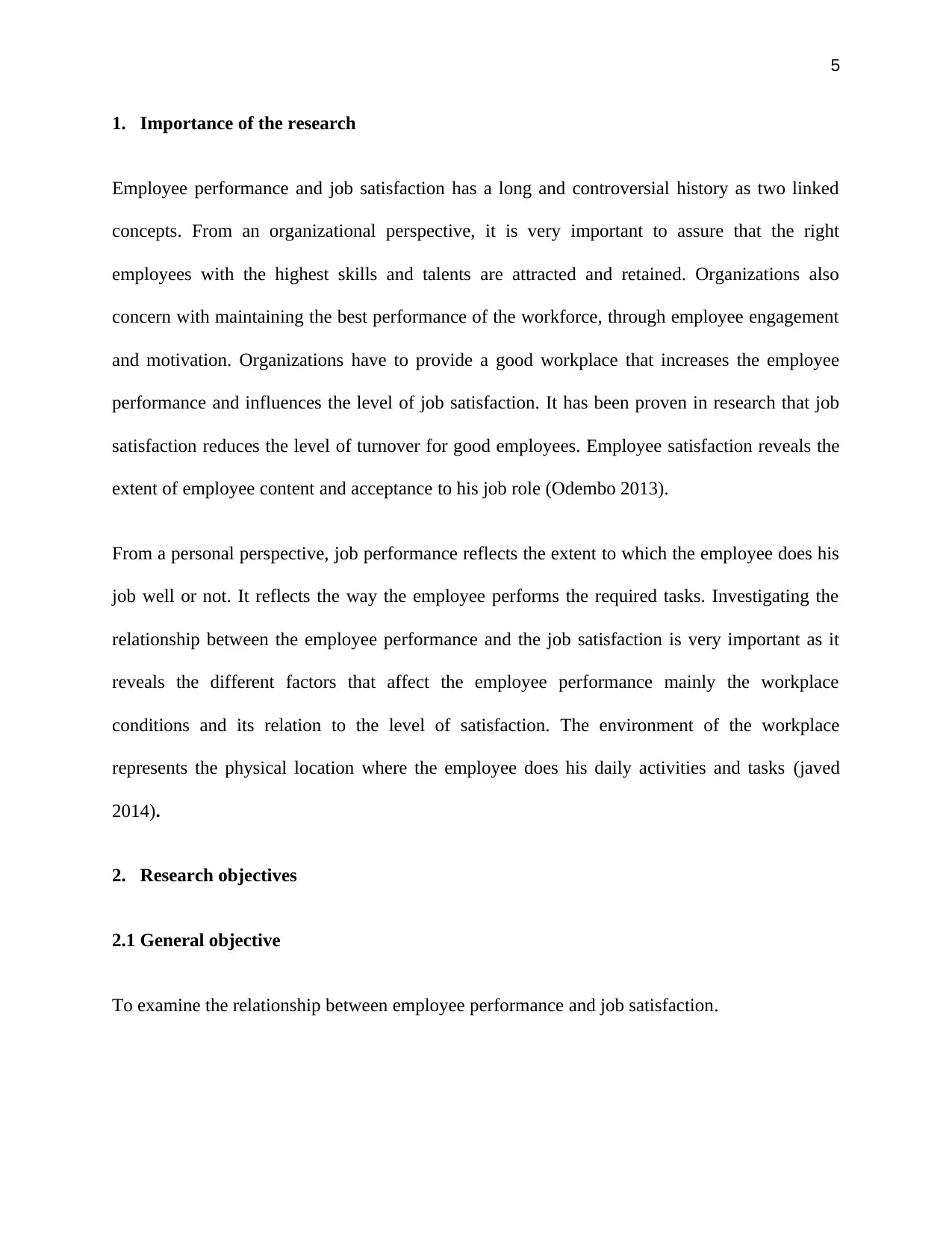
5
1. Importance of the research
Employee performance and job satisfaction has a long and controversial history as two linked
concepts. From an organizational perspective, it is very important to assure that the right
employees with the highest skills and talents are attracted and retained. Organizations also
concern with maintaining the best performance of the workforce, through employee engagement
and motivation. Organizations have to provide a good workplace that increases the employee
performance and influences the level of job satisfaction. It has been proven in research that job
satisfaction reduces the level of turnover for good employees. Employee satisfaction reveals the
extent of employee content and acceptance to his job role (Odembo 2013).
From a personal perspective, job performance reflects the extent to which the employee does his
job well or not. It reflects the way the employee performs the required tasks. Investigating the
relationship between the employee performance and the job satisfaction is very important as it
reveals the different factors that affect the employee performance mainly the workplace
conditions and its relation to the level of satisfaction. The environment of the workplace
represents the physical location where the employee does his daily activities and tasks (javed
2014).
2. Research objectives
2.1 General objective
To examine the relationship between employee performance and job satisfaction.
1. Importance of the research
Employee performance and job satisfaction has a long and controversial history as two linked
concepts. From an organizational perspective, it is very important to assure that the right
employees with the highest skills and talents are attracted and retained. Organizations also
concern with maintaining the best performance of the workforce, through employee engagement
and motivation. Organizations have to provide a good workplace that increases the employee
performance and influences the level of job satisfaction. It has been proven in research that job
satisfaction reduces the level of turnover for good employees. Employee satisfaction reveals the
extent of employee content and acceptance to his job role (Odembo 2013).
From a personal perspective, job performance reflects the extent to which the employee does his
job well or not. It reflects the way the employee performs the required tasks. Investigating the
relationship between the employee performance and the job satisfaction is very important as it
reveals the different factors that affect the employee performance mainly the workplace
conditions and its relation to the level of satisfaction. The environment of the workplace
represents the physical location where the employee does his daily activities and tasks (javed
2014).
2. Research objectives
2.1 General objective
To examine the relationship between employee performance and job satisfaction.
⊘ This is a preview!⊘
Do you want full access?
Subscribe today to unlock all pages.

Trusted by 1+ million students worldwide
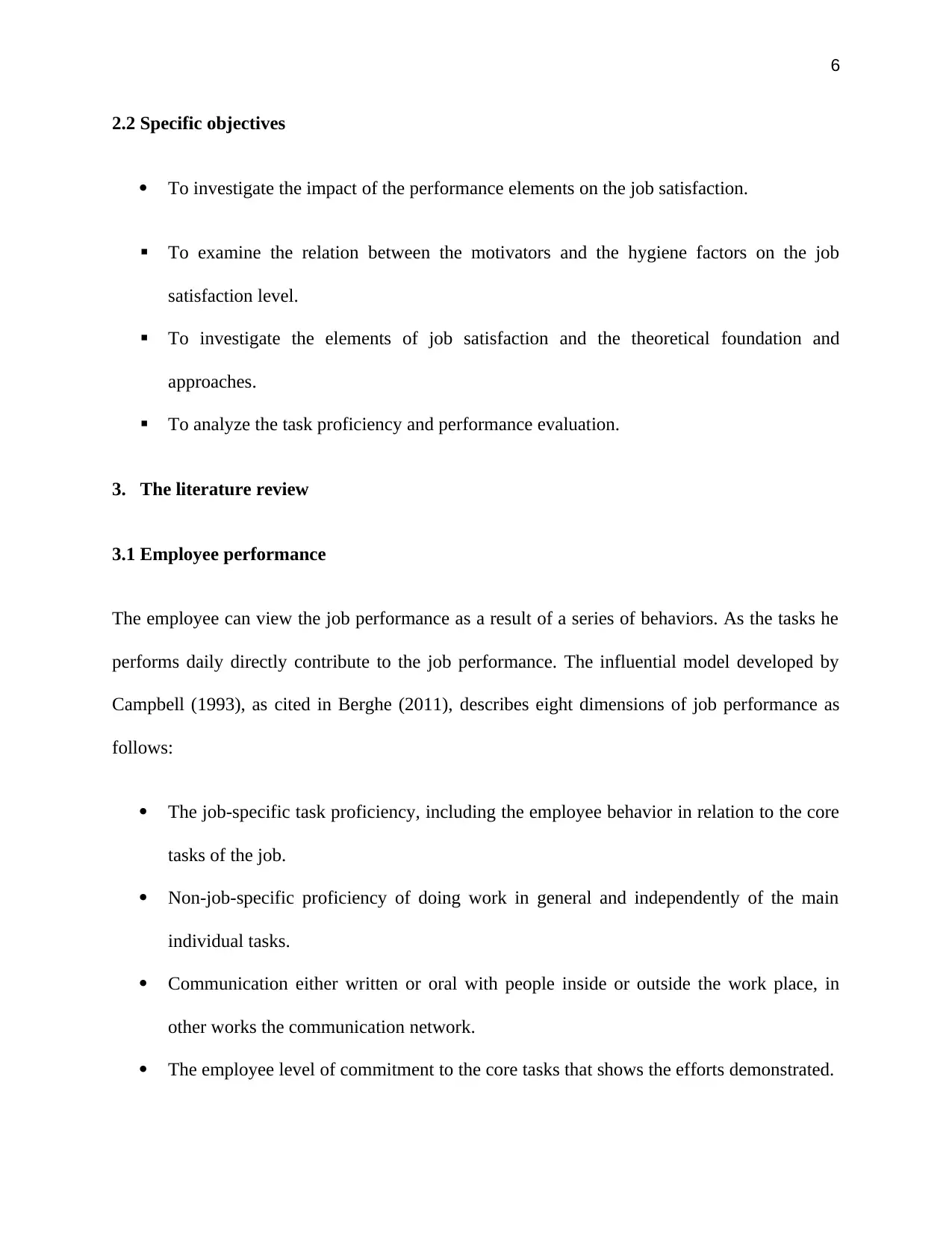
6
2.2 Specific objectives
To investigate the impact of the performance elements on the job satisfaction.
To examine the relation between the motivators and the hygiene factors on the job
satisfaction level.
To investigate the elements of job satisfaction and the theoretical foundation and
approaches.
To analyze the task proficiency and performance evaluation.
3. The literature review
3.1 Employee performance
The employee can view the job performance as a result of a series of behaviors. As the tasks he
performs daily directly contribute to the job performance. The influential model developed by
Campbell (1993), as cited in Berghe (2011), describes eight dimensions of job performance as
follows:
The job-specific task proficiency, including the employee behavior in relation to the core
tasks of the job.
Non-job-specific proficiency of doing work in general and independently of the main
individual tasks.
Communication either written or oral with people inside or outside the work place, in
other works the communication network.
The employee level of commitment to the core tasks that shows the efforts demonstrated.
2.2 Specific objectives
To investigate the impact of the performance elements on the job satisfaction.
To examine the relation between the motivators and the hygiene factors on the job
satisfaction level.
To investigate the elements of job satisfaction and the theoretical foundation and
approaches.
To analyze the task proficiency and performance evaluation.
3. The literature review
3.1 Employee performance
The employee can view the job performance as a result of a series of behaviors. As the tasks he
performs daily directly contribute to the job performance. The influential model developed by
Campbell (1993), as cited in Berghe (2011), describes eight dimensions of job performance as
follows:
The job-specific task proficiency, including the employee behavior in relation to the core
tasks of the job.
Non-job-specific proficiency of doing work in general and independently of the main
individual tasks.
Communication either written or oral with people inside or outside the work place, in
other works the communication network.
The employee level of commitment to the core tasks that shows the efforts demonstrated.
Paraphrase This Document
Need a fresh take? Get an instant paraphrase of this document with our AI Paraphraser
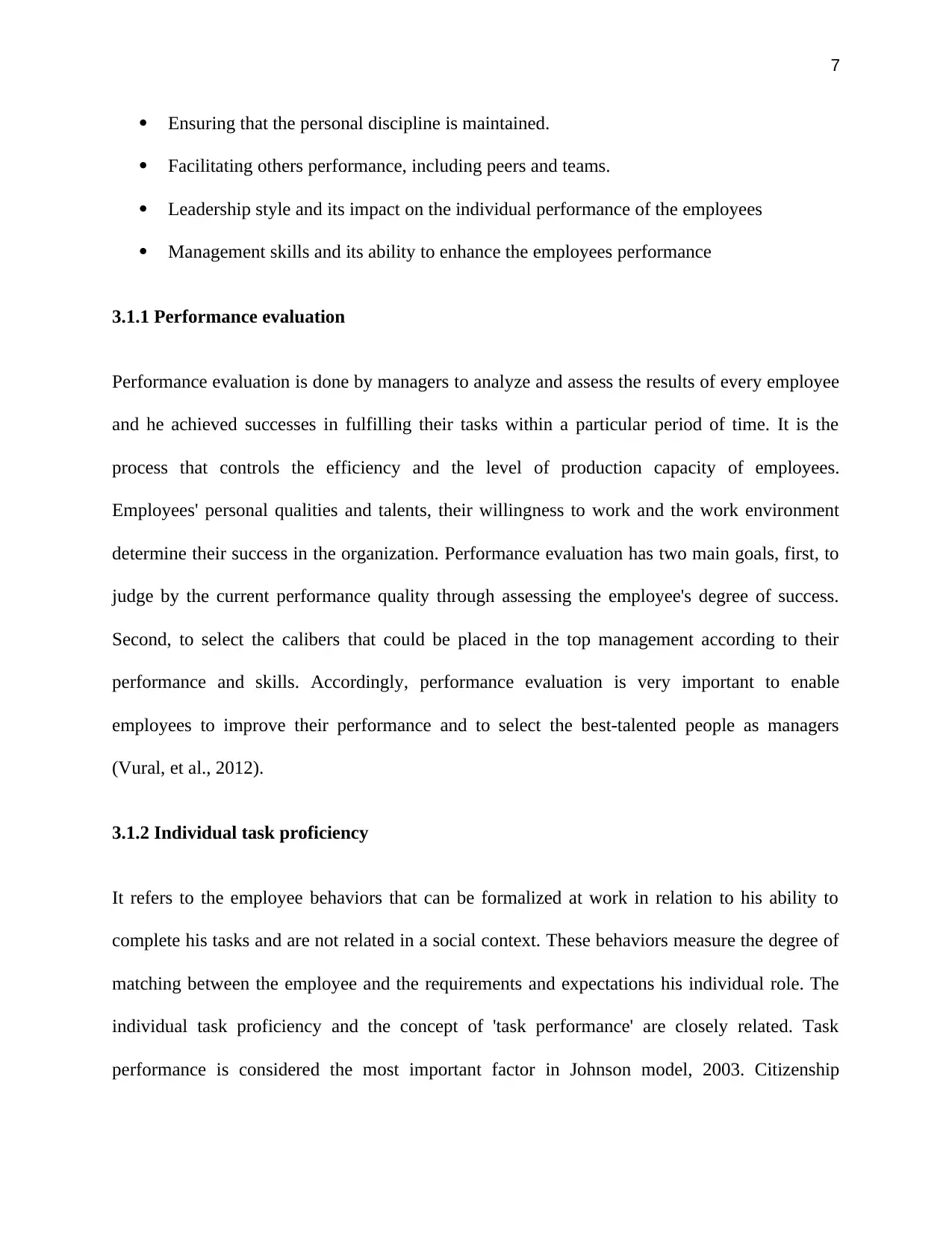
7
Ensuring that the personal discipline is maintained.
Facilitating others performance, including peers and teams.
Leadership style and its impact on the individual performance of the employees
Management skills and its ability to enhance the employees performance
3.1.1 Performance evaluation
Performance evaluation is done by managers to analyze and assess the results of every employee
and he achieved successes in fulfilling their tasks within a particular period of time. It is the
process that controls the efficiency and the level of production capacity of employees.
Employees' personal qualities and talents, their willingness to work and the work environment
determine their success in the organization. Performance evaluation has two main goals, first, to
judge by the current performance quality through assessing the employee's degree of success.
Second, to select the calibers that could be placed in the top management according to their
performance and skills. Accordingly, performance evaluation is very important to enable
employees to improve their performance and to select the best-talented people as managers
(Vural, et al., 2012).
3.1.2 Individual task proficiency
It refers to the employee behaviors that can be formalized at work in relation to his ability to
complete his tasks and are not related in a social context. These behaviors measure the degree of
matching between the employee and the requirements and expectations his individual role. The
individual task proficiency and the concept of 'task performance' are closely related. Task
performance is considered the most important factor in Johnson model, 2003. Citizenship
Ensuring that the personal discipline is maintained.
Facilitating others performance, including peers and teams.
Leadership style and its impact on the individual performance of the employees
Management skills and its ability to enhance the employees performance
3.1.1 Performance evaluation
Performance evaluation is done by managers to analyze and assess the results of every employee
and he achieved successes in fulfilling their tasks within a particular period of time. It is the
process that controls the efficiency and the level of production capacity of employees.
Employees' personal qualities and talents, their willingness to work and the work environment
determine their success in the organization. Performance evaluation has two main goals, first, to
judge by the current performance quality through assessing the employee's degree of success.
Second, to select the calibers that could be placed in the top management according to their
performance and skills. Accordingly, performance evaluation is very important to enable
employees to improve their performance and to select the best-talented people as managers
(Vural, et al., 2012).
3.1.2 Individual task proficiency
It refers to the employee behaviors that can be formalized at work in relation to his ability to
complete his tasks and are not related in a social context. These behaviors measure the degree of
matching between the employee and the requirements and expectations his individual role. The
individual task proficiency and the concept of 'task performance' are closely related. Task
performance is considered the most important factor in Johnson model, 2003. Citizenship
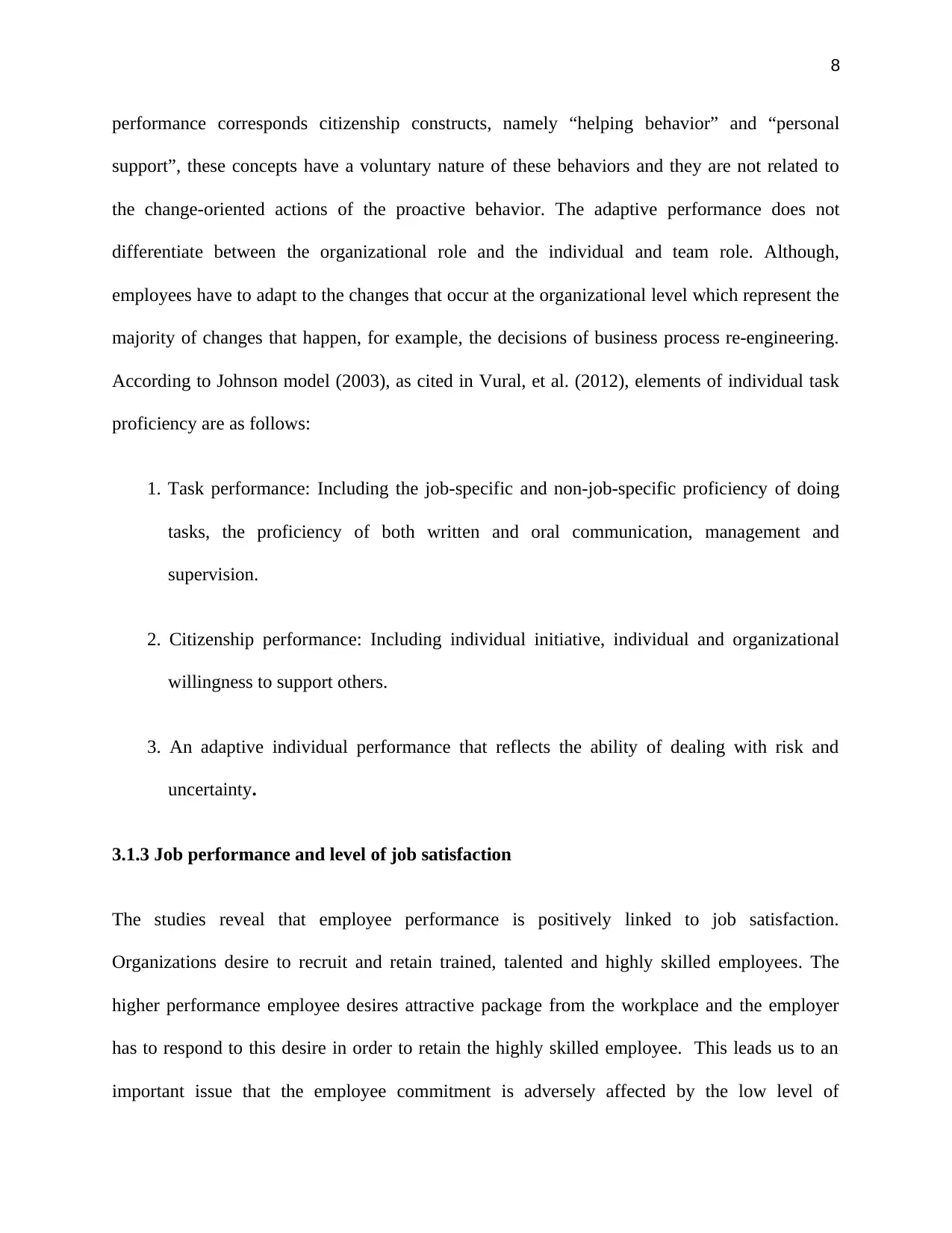
8
performance corresponds citizenship constructs, namely “helping behavior” and “personal
support”, these concepts have a voluntary nature of these behaviors and they are not related to
the change-oriented actions of the proactive behavior. The adaptive performance does not
differentiate between the organizational role and the individual and team role. Although,
employees have to adapt to the changes that occur at the organizational level which represent the
majority of changes that happen, for example, the decisions of business process re-engineering.
According to Johnson model (2003), as cited in Vural, et al. (2012), elements of individual task
proficiency are as follows:
1. Task performance: Including the job-specific and non-job-specific proficiency of doing
tasks, the proficiency of both written and oral communication, management and
supervision.
2. Citizenship performance: Including individual initiative, individual and organizational
willingness to support others.
3. An adaptive individual performance that reflects the ability of dealing with risk and
uncertainty.
3.1.3 Job performance and level of job satisfaction
The studies reveal that employee performance is positively linked to job satisfaction.
Organizations desire to recruit and retain trained, talented and highly skilled employees. The
higher performance employee desires attractive package from the workplace and the employer
has to respond to this desire in order to retain the highly skilled employee. This leads us to an
important issue that the employee commitment is adversely affected by the low level of
performance corresponds citizenship constructs, namely “helping behavior” and “personal
support”, these concepts have a voluntary nature of these behaviors and they are not related to
the change-oriented actions of the proactive behavior. The adaptive performance does not
differentiate between the organizational role and the individual and team role. Although,
employees have to adapt to the changes that occur at the organizational level which represent the
majority of changes that happen, for example, the decisions of business process re-engineering.
According to Johnson model (2003), as cited in Vural, et al. (2012), elements of individual task
proficiency are as follows:
1. Task performance: Including the job-specific and non-job-specific proficiency of doing
tasks, the proficiency of both written and oral communication, management and
supervision.
2. Citizenship performance: Including individual initiative, individual and organizational
willingness to support others.
3. An adaptive individual performance that reflects the ability of dealing with risk and
uncertainty.
3.1.3 Job performance and level of job satisfaction
The studies reveal that employee performance is positively linked to job satisfaction.
Organizations desire to recruit and retain trained, talented and highly skilled employees. The
higher performance employee desires attractive package from the workplace and the employer
has to respond to this desire in order to retain the highly skilled employee. This leads us to an
important issue that the employee commitment is adversely affected by the low level of
⊘ This is a preview!⊘
Do you want full access?
Subscribe today to unlock all pages.

Trusted by 1+ million students worldwide
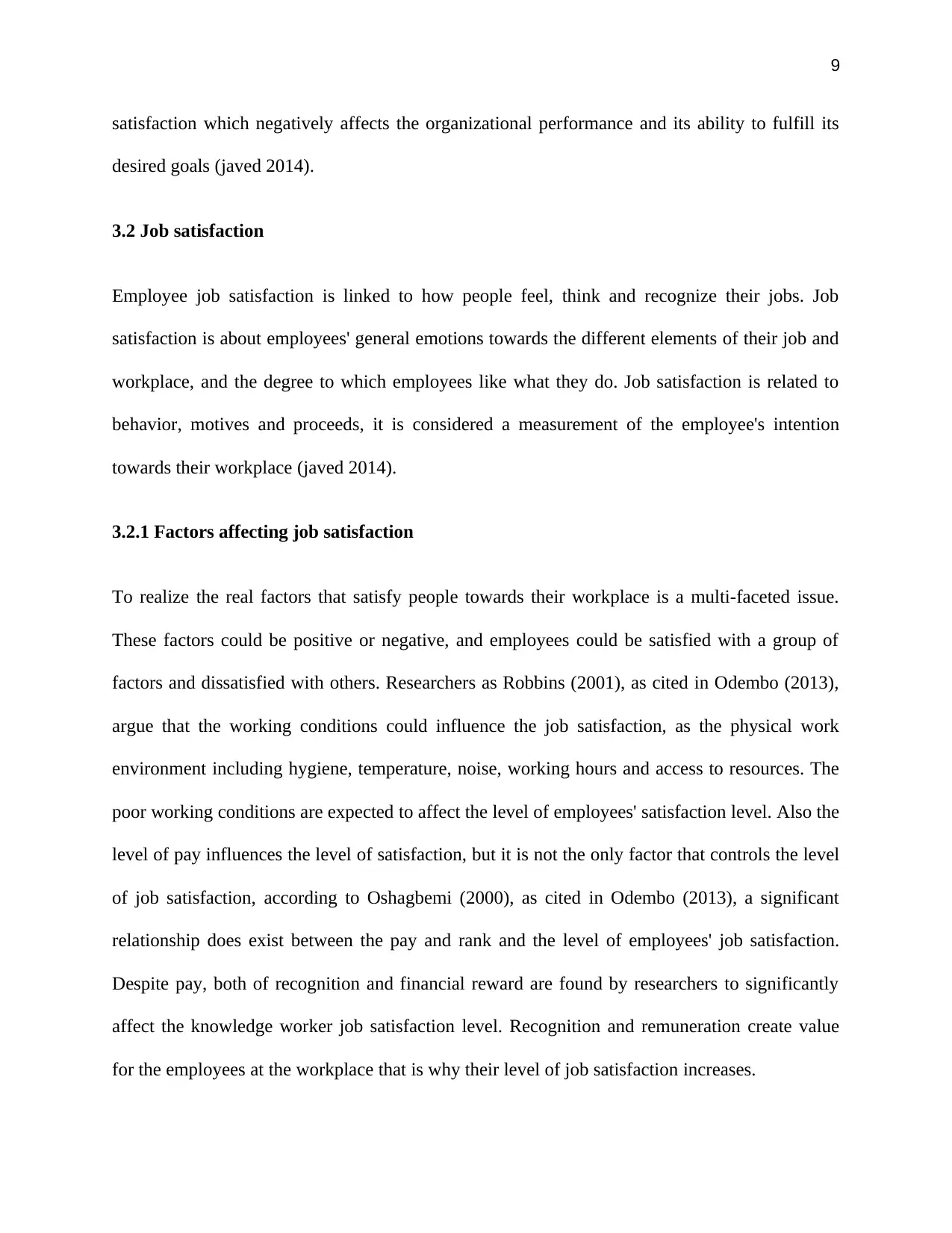
9
satisfaction which negatively affects the organizational performance and its ability to fulfill its
desired goals (javed 2014).
3.2 Job satisfaction
Employee job satisfaction is linked to how people feel, think and recognize their jobs. Job
satisfaction is about employees' general emotions towards the different elements of their job and
workplace, and the degree to which employees like what they do. Job satisfaction is related to
behavior, motives and proceeds, it is considered a measurement of the employee's intention
towards their workplace (javed 2014).
3.2.1 Factors affecting job satisfaction
To realize the real factors that satisfy people towards their workplace is a multi-faceted issue.
These factors could be positive or negative, and employees could be satisfied with a group of
factors and dissatisfied with others. Researchers as Robbins (2001), as cited in Odembo (2013),
argue that the working conditions could influence the job satisfaction, as the physical work
environment including hygiene, temperature, noise, working hours and access to resources. The
poor working conditions are expected to affect the level of employees' satisfaction level. Also the
level of pay influences the level of satisfaction, but it is not the only factor that controls the level
of job satisfaction, according to Oshagbemi (2000), as cited in Odembo (2013), a significant
relationship does exist between the pay and rank and the level of employees' job satisfaction.
Despite pay, both of recognition and financial reward are found by researchers to significantly
affect the knowledge worker job satisfaction level. Recognition and remuneration create value
for the employees at the workplace that is why their level of job satisfaction increases.
satisfaction which negatively affects the organizational performance and its ability to fulfill its
desired goals (javed 2014).
3.2 Job satisfaction
Employee job satisfaction is linked to how people feel, think and recognize their jobs. Job
satisfaction is about employees' general emotions towards the different elements of their job and
workplace, and the degree to which employees like what they do. Job satisfaction is related to
behavior, motives and proceeds, it is considered a measurement of the employee's intention
towards their workplace (javed 2014).
3.2.1 Factors affecting job satisfaction
To realize the real factors that satisfy people towards their workplace is a multi-faceted issue.
These factors could be positive or negative, and employees could be satisfied with a group of
factors and dissatisfied with others. Researchers as Robbins (2001), as cited in Odembo (2013),
argue that the working conditions could influence the job satisfaction, as the physical work
environment including hygiene, temperature, noise, working hours and access to resources. The
poor working conditions are expected to affect the level of employees' satisfaction level. Also the
level of pay influences the level of satisfaction, but it is not the only factor that controls the level
of job satisfaction, according to Oshagbemi (2000), as cited in Odembo (2013), a significant
relationship does exist between the pay and rank and the level of employees' job satisfaction.
Despite pay, both of recognition and financial reward are found by researchers to significantly
affect the knowledge worker job satisfaction level. Recognition and remuneration create value
for the employees at the workplace that is why their level of job satisfaction increases.
Paraphrase This Document
Need a fresh take? Get an instant paraphrase of this document with our AI Paraphraser
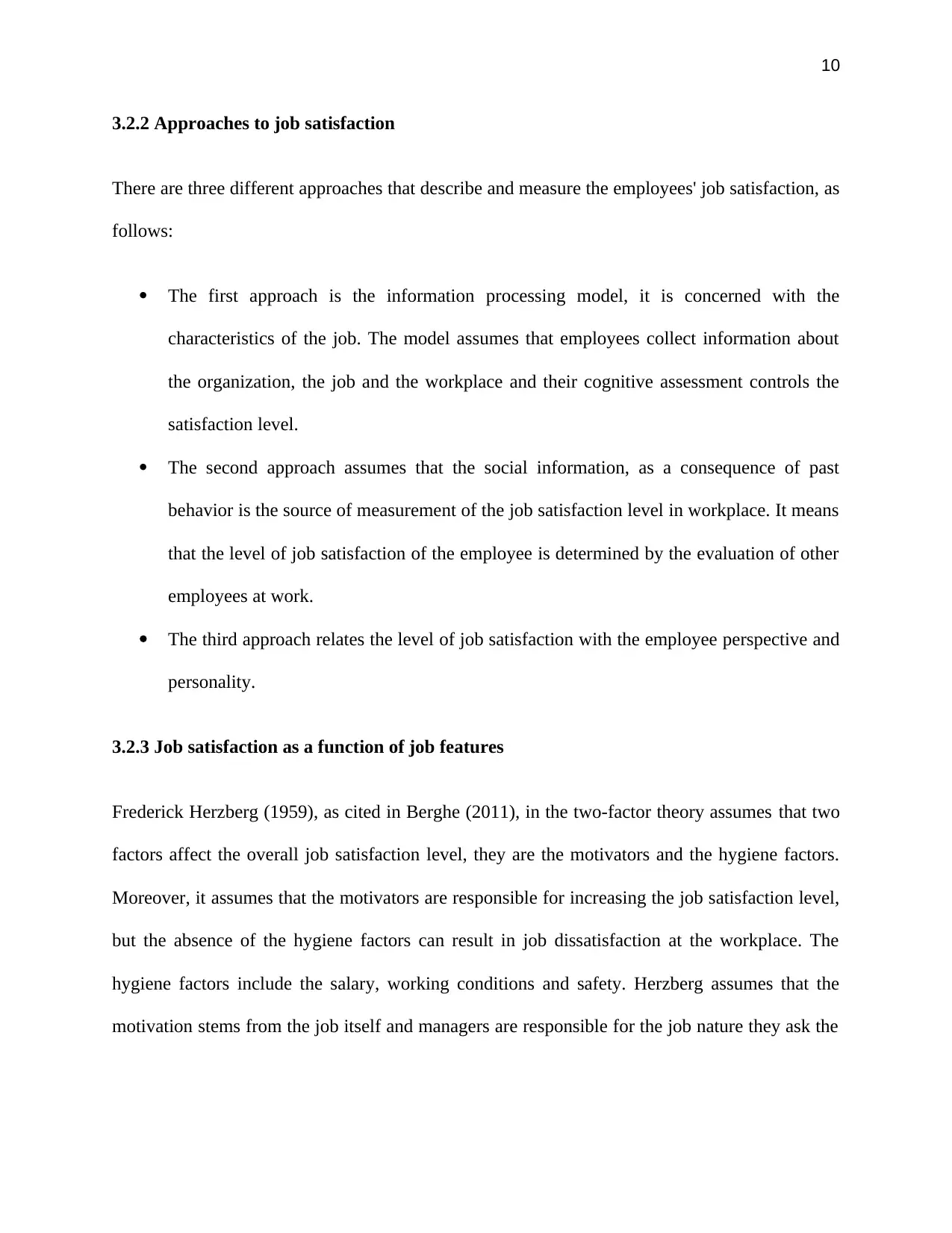
10
3.2.2 Approaches to job satisfaction
There are three different approaches that describe and measure the employees' job satisfaction, as
follows:
The first approach is the information processing model, it is concerned with the
characteristics of the job. The model assumes that employees collect information about
the organization, the job and the workplace and their cognitive assessment controls the
satisfaction level.
The second approach assumes that the social information, as a consequence of past
behavior is the source of measurement of the job satisfaction level in workplace. It means
that the level of job satisfaction of the employee is determined by the evaluation of other
employees at work.
The third approach relates the level of job satisfaction with the employee perspective and
personality.
3.2.3 Job satisfaction as a function of job features
Frederick Herzberg (1959), as cited in Berghe (2011), in the two-factor theory assumes that two
factors affect the overall job satisfaction level, they are the motivators and the hygiene factors.
Moreover, it assumes that the motivators are responsible for increasing the job satisfaction level,
but the absence of the hygiene factors can result in job dissatisfaction at the workplace. The
hygiene factors include the salary, working conditions and safety. Herzberg assumes that the
motivation stems from the job itself and managers are responsible for the job nature they ask the
3.2.2 Approaches to job satisfaction
There are three different approaches that describe and measure the employees' job satisfaction, as
follows:
The first approach is the information processing model, it is concerned with the
characteristics of the job. The model assumes that employees collect information about
the organization, the job and the workplace and their cognitive assessment controls the
satisfaction level.
The second approach assumes that the social information, as a consequence of past
behavior is the source of measurement of the job satisfaction level in workplace. It means
that the level of job satisfaction of the employee is determined by the evaluation of other
employees at work.
The third approach relates the level of job satisfaction with the employee perspective and
personality.
3.2.3 Job satisfaction as a function of job features
Frederick Herzberg (1959), as cited in Berghe (2011), in the two-factor theory assumes that two
factors affect the overall job satisfaction level, they are the motivators and the hygiene factors.
Moreover, it assumes that the motivators are responsible for increasing the job satisfaction level,
but the absence of the hygiene factors can result in job dissatisfaction at the workplace. The
hygiene factors include the salary, working conditions and safety. Herzberg assumes that the
motivation stems from the job itself and managers are responsible for the job nature they ask the
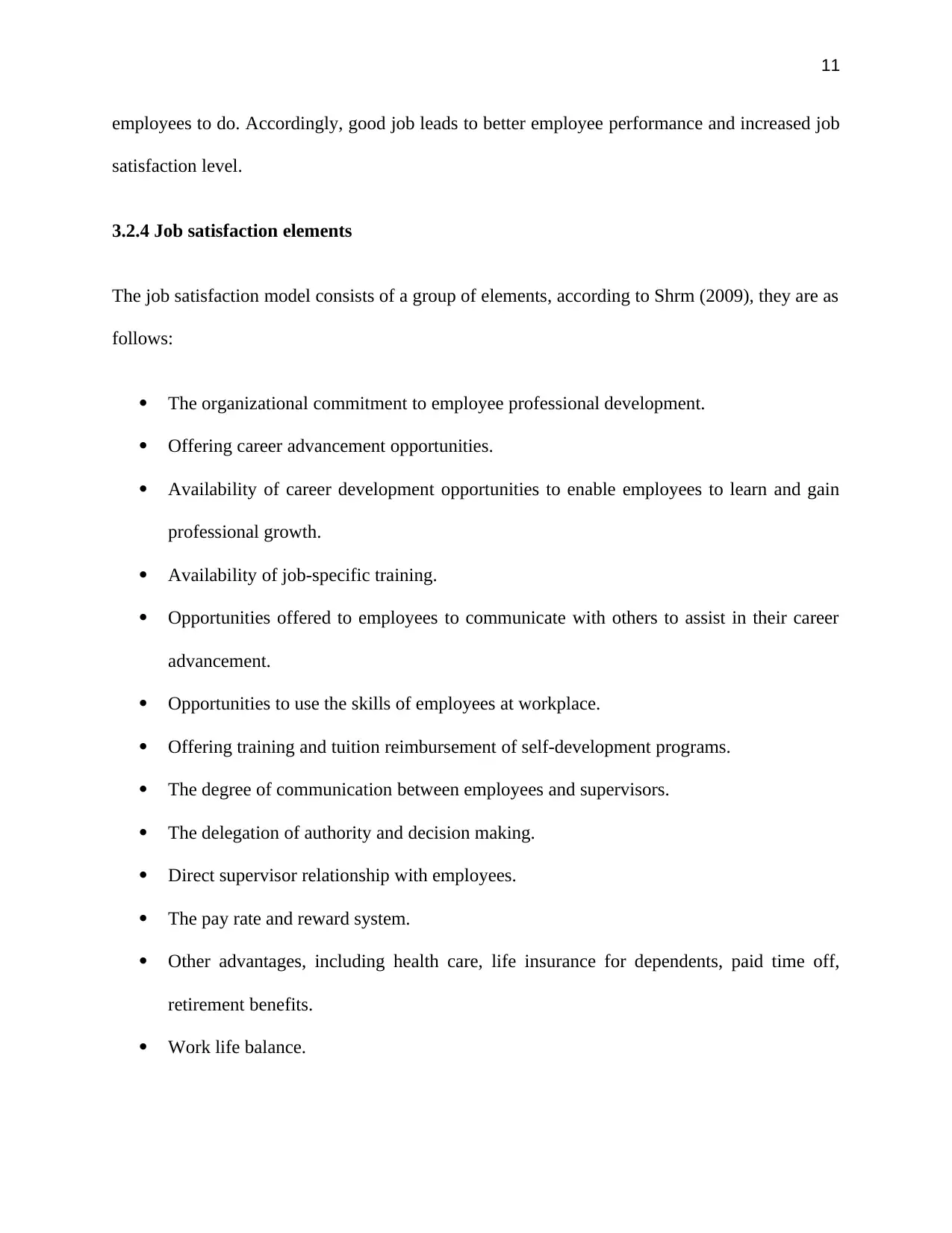
11
employees to do. Accordingly, good job leads to better employee performance and increased job
satisfaction level.
3.2.4 Job satisfaction elements
The job satisfaction model consists of a group of elements, according to Shrm (2009), they are as
follows:
The organizational commitment to employee professional development.
Offering career advancement opportunities.
Availability of career development opportunities to enable employees to learn and gain
professional growth.
Availability of job-specific training.
Opportunities offered to employees to communicate with others to assist in their career
advancement.
Opportunities to use the skills of employees at workplace.
Offering training and tuition reimbursement of self-development programs.
The degree of communication between employees and supervisors.
The delegation of authority and decision making.
Direct supervisor relationship with employees.
The pay rate and reward system.
Other advantages, including health care, life insurance for dependents, paid time off,
retirement benefits.
Work life balance.
employees to do. Accordingly, good job leads to better employee performance and increased job
satisfaction level.
3.2.4 Job satisfaction elements
The job satisfaction model consists of a group of elements, according to Shrm (2009), they are as
follows:
The organizational commitment to employee professional development.
Offering career advancement opportunities.
Availability of career development opportunities to enable employees to learn and gain
professional growth.
Availability of job-specific training.
Opportunities offered to employees to communicate with others to assist in their career
advancement.
Opportunities to use the skills of employees at workplace.
Offering training and tuition reimbursement of self-development programs.
The degree of communication between employees and supervisors.
The delegation of authority and decision making.
Direct supervisor relationship with employees.
The pay rate and reward system.
Other advantages, including health care, life insurance for dependents, paid time off,
retirement benefits.
Work life balance.
⊘ This is a preview!⊘
Do you want full access?
Subscribe today to unlock all pages.

Trusted by 1+ million students worldwide
1 out of 22
Related Documents
Your All-in-One AI-Powered Toolkit for Academic Success.
+13062052269
info@desklib.com
Available 24*7 on WhatsApp / Email
![[object Object]](/_next/static/media/star-bottom.7253800d.svg)
Unlock your academic potential
Copyright © 2020–2025 A2Z Services. All Rights Reserved. Developed and managed by ZUCOL.





